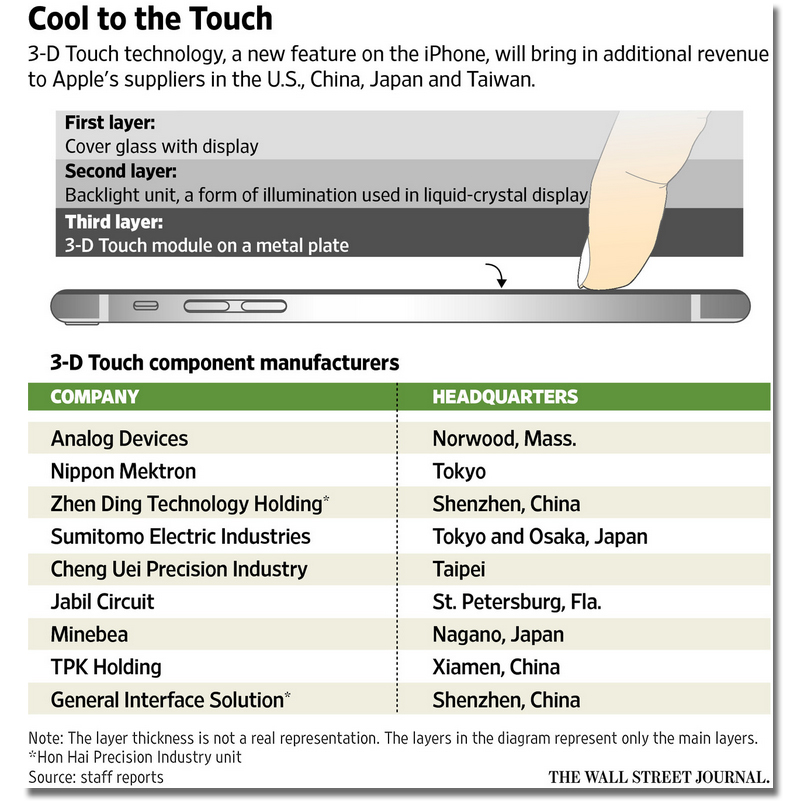Apple Suppliers Hope to Tap Into New ‘3-D Touch’

Apple assemblers in Asia and U.S. could gain earnings boost, if devices are a success - the new touch technology is expected to bring in new demand to the supply chain and it could be a catalyst to stimulate smartphone demand.
As reported in The Wall Street Journal, if Apple’s new iPhones that feature a new touch technology are a hit with consumers, a handful of supply chain component suppliers across Asia and the U.S. stand to be significant beneficiaries.
The Cupertino company on Wednesday unveiled a pair of new iPhones with “3-D Touch” technology, which can distinguish between a light tap and a heavier press, allowing users to control a device differently depending on how hard they push on a surface. Apple is the first company to feature the technology, in its smartwatches and MacBook computers.
Like many other handset providers, Apple doesn’t make its phones but hires assemblers such as Taiwan-based Hon Hai Precision Industry Co. - also known by the trade name Foxconn Technology Group - to put together its gadgets based on its own designs. Apple uses parts from other outside suppliers, many of which are from Taiwan and elsewhere in Asia, freeing up the company from running labor-intensive production lines.
“The new touch technology is expected to bring in new demand to the supply chain and it could be a catalyst to stimulate smartphone demand,” said Freddie Liu, chief financial officer of China-based touch-screen maker TPK Holding Co.
The proportion of such touch-enabled smartphones world-wide could rise to 19% of the global smartphone market next year from 3% this year and grow further to 28% in 2017, research firm Counterpoint said. Neil Shah, an analyst at Counterpoint, estimates that the use of technology like 3-D Touch in smartphones could add more than $6 billion in potential revenue to suppliers over the next two years.
Apple’s 3-D Touch requires a special process combining layers of components by using heat and pressure. This has put Chinese touch-screen makers TPK and General Interface Solution Ltd., a Foxconn unit, in the spotlight. Both suppliers failed to win orders for iPhones since late 2012 as Apple switched to a new display technology to make its phone screens thinner. But in the latest iPhones, these companies will combine 3-D Touch components with the display’s backlight, according to people familiar with the matter.
Fubon Research forecasts new orders would bring in US$450 million in additional revenue to Taiwan-listed TPK, representing 10% of its total revenue this year. TPK’s revenue fell 19% to 129.5 billion New Taiwan dollars (US$3.98 billion) in 2014 because of sluggish demand for touch screens used in non-Apple devices. Fubon said TPK is likely to report a decline in profit margin this year despite Apple’s orders because of investments in new production facilities and intensifying price competition.
Mr. Liu declined to comment about the revenue contribution expected from new orders. Shares in TPK fell slightly to NT$92 on Thursday.
3-D Touch also requires flexible printed circuit boards to connect the processor with other electronic components. People familiar with the matter said U.S. based Analog Devices Inc. will be the exclusive supplier of the component. Morgan Stanley last month raised Analog Devices’ price target to $62 from $60, citing strong demand for the company’s 3-D Touch processor for Apple’s iPhones. Analog Devices declined to comment.
Foxconn’s semiconductor unit, Zhen Ding Technology Holding Ltd., as well as Japanese electronic-parts makers Nippon Mektron Ltd. and Sumitomo Electric Industries Ltd. are suppliers of the flexible printed circuit boards used in the new iPhones, people familiar with the matter said. Zhen Ding, Nippon and Sumitomo declined to comment.
Apple’s 3-D Touch components also require metal shield plates to provide support, and Nagano-based electronics company Minebea Co. and U.S. contract manufacturer Jabil Circuit Inc. are the main suppliers, according to people familiar with the matter. Both companies declined to comment.
Apple declined to comment about its supply chain.
More handset makers will incorporate the touch feature to their smartphones this year, analysts say, which will create revenue opportunities for parts makers. Last week Chinese smartphone maker Huawei Technologies Co. introduced a new flagship phone at the IFA electronics show in Germany, touting a touch technology similar to 3-D Touch.
“We expect major smartphone makers to use the new touch technology to differentiate their premium smartphones as the market gets competitive,” Canalys analyst Nicole Peng said.
Apple said it is launching the new iPhones across 12 countries including the U.S., China, U.K, Australia and Japan starting on Sept. 25.
In its fiscal quarter ended June 27, the company sold 47.5 million units, up 35% from a year earlier.
Source: The Wall Street Journal
News: Amazon says it has ended sales of Fire Phone
Amazon.com Inc. has discontinued sales of its so-called Fire Phone. The Seattle-based online retailing giant has depleted its inventory and has no plans to offer more of the smartphone, an Amazon spokeswoman told MarketWatch in an emailed response. She said Amazon wouldn’t replenish its stock of smartphones but would “continue to support its customers using [the] Fire Phone.”
Related: Has ‘Supply Chain Strain’ Become The New Norm?

Article Topics
SupplyChainOpz News & Resources
Is Apple Working on a Trump Contingency Plan? A Case Study of Apple Computer’s Supplier Hubs: A Tale of Two Cities The 7 Principles of Supply Chain Management Samsung’s Galaxy Note 7 Supply Chain on Fire Google Overtakes Apple as Most Valuable Company Apple Suppliers Hope to Tap Into New ‘3-D Touch’ Apple iPhone Sales Slack Says Supply Chain Leak More SupplyChainOpzLatest in Supply Chain
Ranking the World’s 10 Biggest Supply Chains The Top 10 Risks Facing Supply Chain Professionals Walmart’s Latest Service: Ultra Late-Night Delivery Dollar Tree’s Oklahoma Distribution Center Decimated by Tornado The Era of Self-Driving Tractor-Trailers Set to Begin Is the Trailers as a Service (TaaS) Model Right For Your Business? Why Grocery Shoppers are Leaving Stores to Buy Their Food Online More Supply Chain














